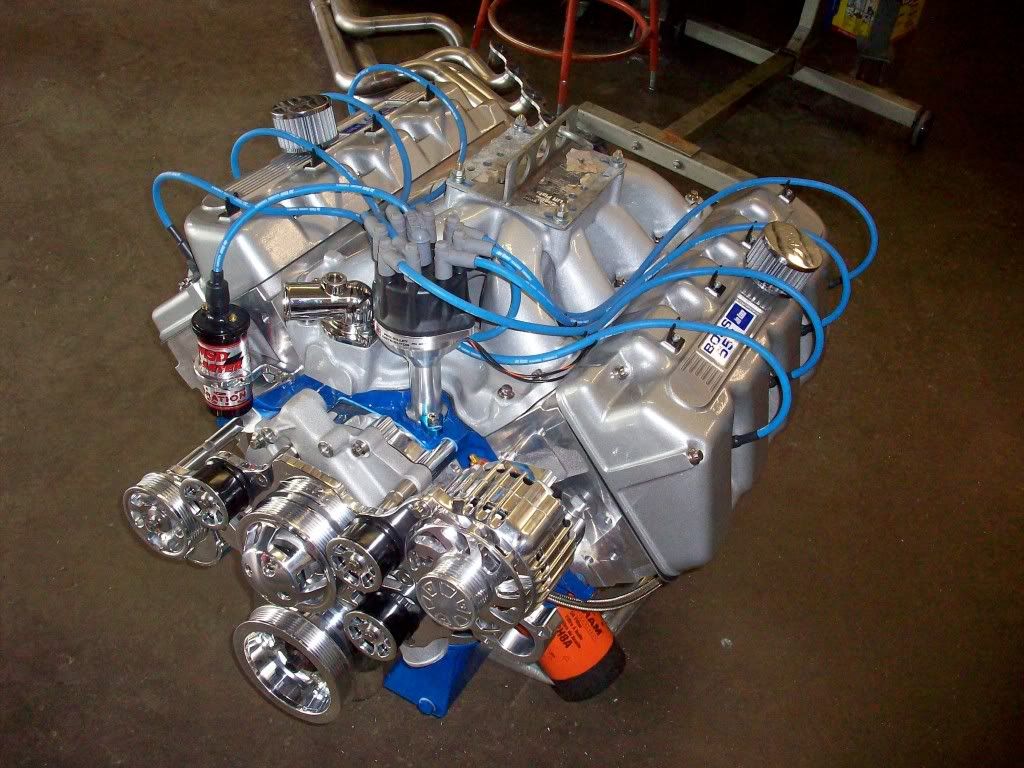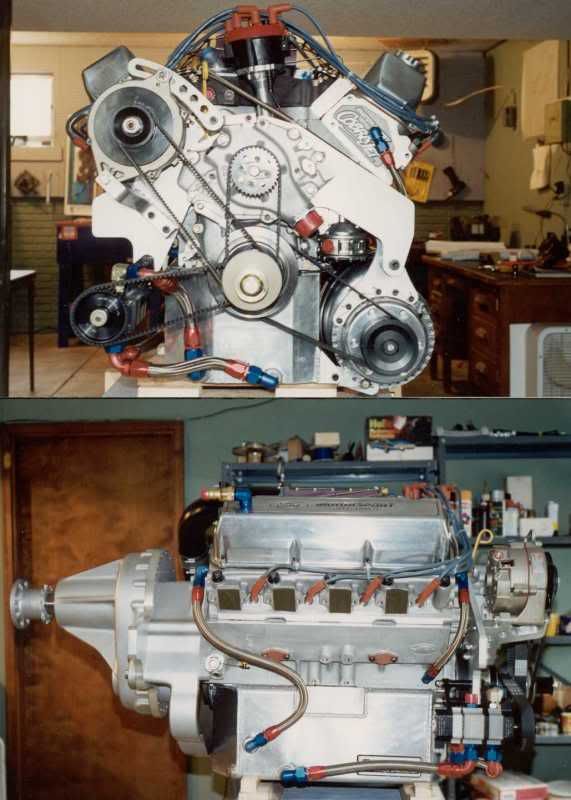Ron Earp
Admin
I know this isn't an engine for GT40 application but there are a lot of smart folks on this forum. Mostly. Well, a few...
I’m slowly assembling parts for a 385-series big block for my Torino. I’ve got a good Ford builder that is local to me and he knows his stuff well. But, he won’t tell me what to build as he likes to make sure the customer knows what s/he is getting into. <o ></o
></o >
>
<o > </o
> </o >
>
The intended use for the car is simply a street machine with a bent toward road course work. Not wheel to wheel racing mind you, but club track days. As such the car will be built with various components to make it safe, handle, stop, and of course go. It needs to do the things big blocks do - make a lot of noise, scare women and children, and quite naturally be reliable.<o ></o
></o >
>
<o > </o
> </o >
>
The cylinder heads have been decided on, some aluminum Super Cobra Jet heads. The builder is very familiar with them and feels confident he can make them do whatever we want from mild to wild The block will be a production block, not an SVO block. We’ll be running a carb and most likely a solid roller cam. A forged crank and rods will be used.<o ></o
></o >
>
<o > </o
> </o >
>
What isn’t decided is displacement. Rick has built pretty much all sizes of 385 motors up to 600 inches and they’ve been used mainly in drag cars and mud trucks. With the parts choices and prices it is a fairly simple thing to build a high quality 550+ inch stroker. Sort of hard to resist actually and makes you wonder why anyone would mess around with small multivalve/multicam engines with turbos and superchargers.
<o > </o
> </o >
>
But I need to decide on a displacement that will do what I want. I want it to have plenty of power for a 3600 lb car. It needs to turn RPM, around 7k. I’m going to keep the Toploader and that means no OD top gear. I don’t want to have to be lifting on the straight at 6000 RPM because the engine won’t turn and I’m not planning on running a numerically low ring and pinion.<o ></o
></o >
>
<o > </o
> </o >
>
There are many engine bore/stroke combinations but here are some common ones in various bore dimensions. Data shows stroke, cubic inches, and bore/stroke ratio:<o ></o
></o >
>
<o > </o
> </o >
>
Using a 4.360 Bore<o ></o
></o >
>
3.85” 460CI 1.13<o ></o
></o >
>
4.15” 503CI 1.06<o ></o
></o >
>
4.50” 546CI 0.98<o ></o
></o >
>
<o > </o
> </o >
>
Using a 4.450 Bore<o ></o
></o >
>
3.85” 480CI 1.16<o ></o
></o >
>
4.15” 517CI 1.07<o ></o
></o >
>
4.50” 561CI 0.99<o ></o
></o >
>
<o > </o
> </o >
>
One part of me is tempted to go with the 3.85” stroke because I feel it’ll rev better. I also feel that the “small” engine might not have the propensity to produce gobs of possibly useless hp and torque. Plus, if you can’t get it done with 460-480 inches does it need doing anyway?<o ></o
></o >
>
<o > </o
> </o >
>
But the better half of me says more is better. If 480” is good, 560” must be a lot better. The guys that run some the large 385-series strokers rev the hell out of them, 8-9k in some of these things and simply hold their foot down until the motor gets done whatever needs doing. So the “revability” and “breakability” might all be some theoretical conjecture that while true might be slightly different in application.<o ></o
></o >
>
<o > </o
> </o >
>
So I could compromise and use a 4.150” stroke and sort of be middle of the road. But that would kind of stink to have some Bowtie guy to show up with his 572” motor, now wouldn’t it?<o ></o
></o >
>
I’m slowly assembling parts for a 385-series big block for my Torino. I’ve got a good Ford builder that is local to me and he knows his stuff well. But, he won’t tell me what to build as he likes to make sure the customer knows what s/he is getting into. <o
<o
The intended use for the car is simply a street machine with a bent toward road course work. Not wheel to wheel racing mind you, but club track days. As such the car will be built with various components to make it safe, handle, stop, and of course go. It needs to do the things big blocks do - make a lot of noise, scare women and children, and quite naturally be reliable.<o
<o
The cylinder heads have been decided on, some aluminum Super Cobra Jet heads. The builder is very familiar with them and feels confident he can make them do whatever we want from mild to wild The block will be a production block, not an SVO block. We’ll be running a carb and most likely a solid roller cam. A forged crank and rods will be used.<o
<o
What isn’t decided is displacement. Rick has built pretty much all sizes of 385 motors up to 600 inches and they’ve been used mainly in drag cars and mud trucks. With the parts choices and prices it is a fairly simple thing to build a high quality 550+ inch stroker. Sort of hard to resist actually and makes you wonder why anyone would mess around with small multivalve/multicam engines with turbos and superchargers.
<o
But I need to decide on a displacement that will do what I want. I want it to have plenty of power for a 3600 lb car. It needs to turn RPM, around 7k. I’m going to keep the Toploader and that means no OD top gear. I don’t want to have to be lifting on the straight at 6000 RPM because the engine won’t turn and I’m not planning on running a numerically low ring and pinion.<o
<o
There are many engine bore/stroke combinations but here are some common ones in various bore dimensions. Data shows stroke, cubic inches, and bore/stroke ratio:<o
<o
Using a 4.360 Bore<o
3.85” 460CI 1.13<o
4.15” 503CI 1.06<o
4.50” 546CI 0.98<o
<o
Using a 4.450 Bore<o
3.85” 480CI 1.16<o
4.15” 517CI 1.07<o
4.50” 561CI 0.99<o
<o
One part of me is tempted to go with the 3.85” stroke because I feel it’ll rev better. I also feel that the “small” engine might not have the propensity to produce gobs of possibly useless hp and torque. Plus, if you can’t get it done with 460-480 inches does it need doing anyway?<o
<o
But the better half of me says more is better. If 480” is good, 560” must be a lot better. The guys that run some the large 385-series strokers rev the hell out of them, 8-9k in some of these things and simply hold their foot down until the motor gets done whatever needs doing. So the “revability” and “breakability” might all be some theoretical conjecture that while true might be slightly different in application.<o
<o
So I could compromise and use a 4.150” stroke and sort of be middle of the road. But that would kind of stink to have some Bowtie guy to show up with his 572” motor, now wouldn’t it?<o




